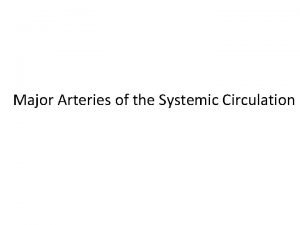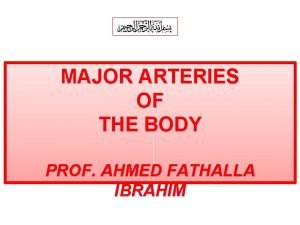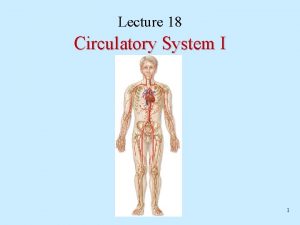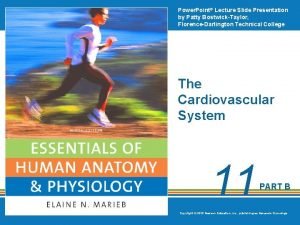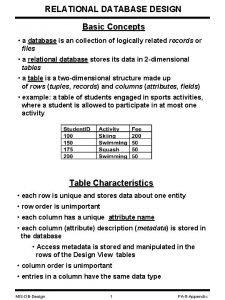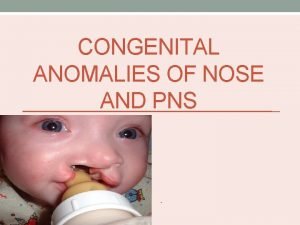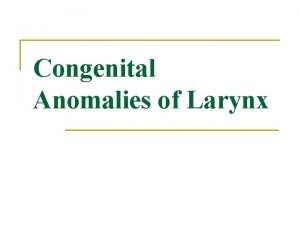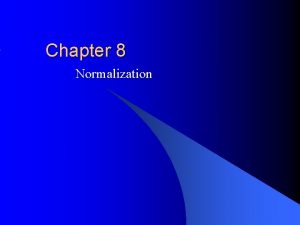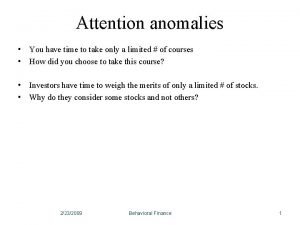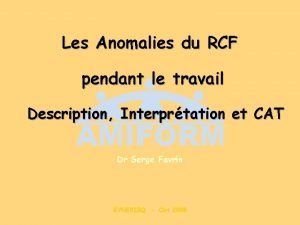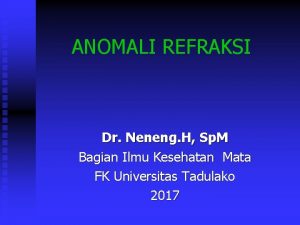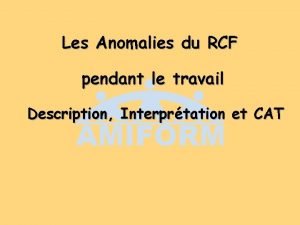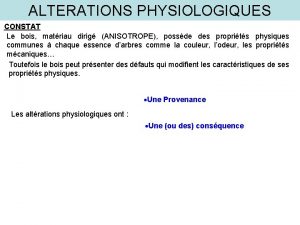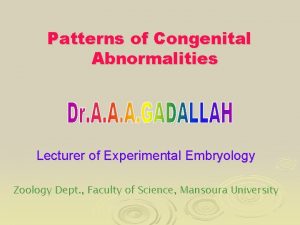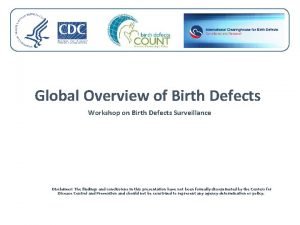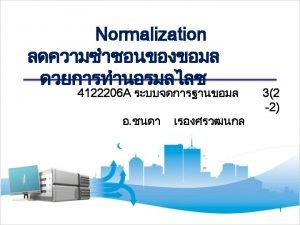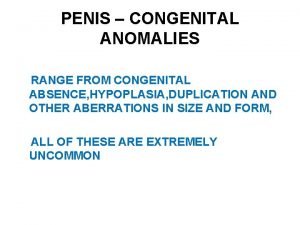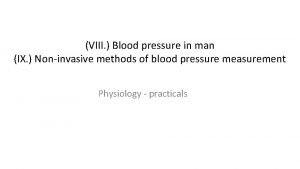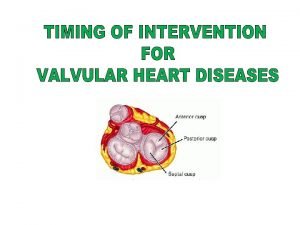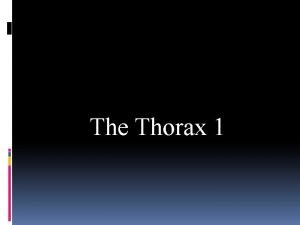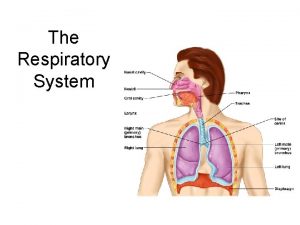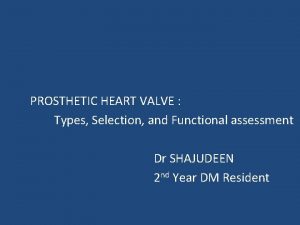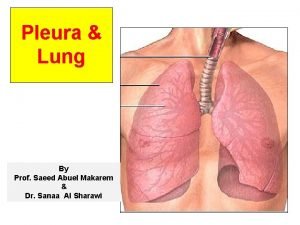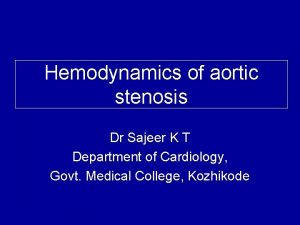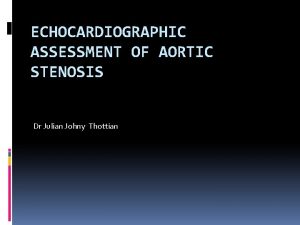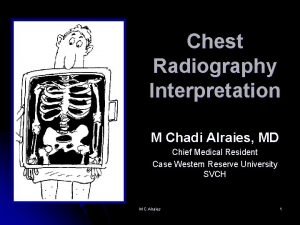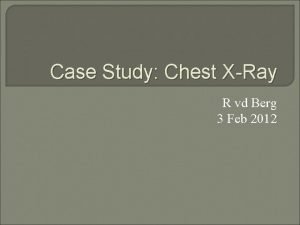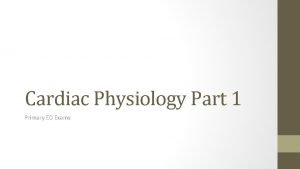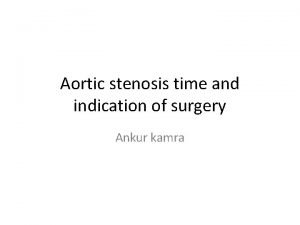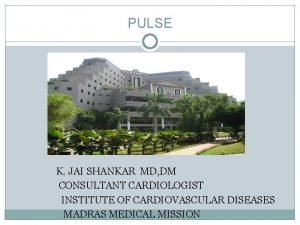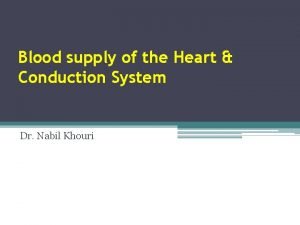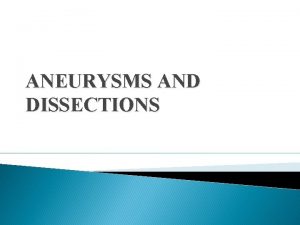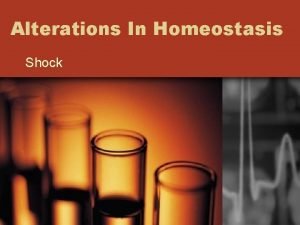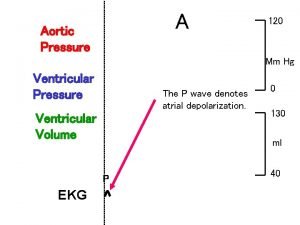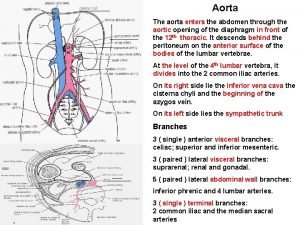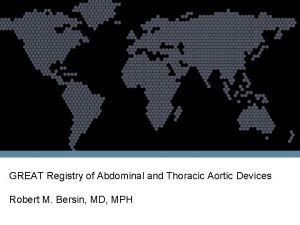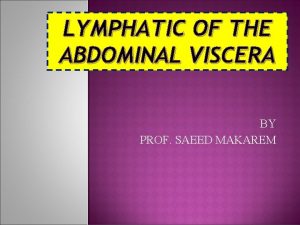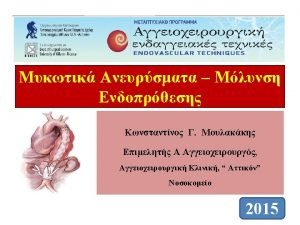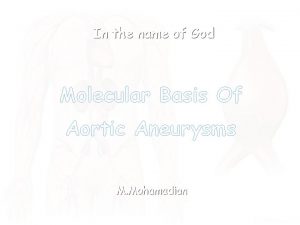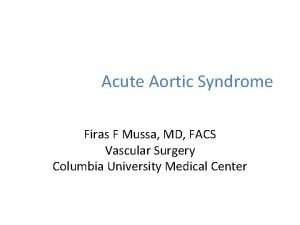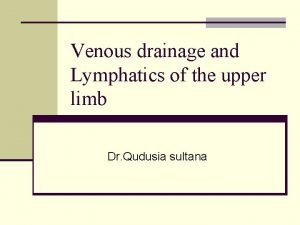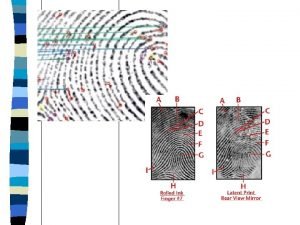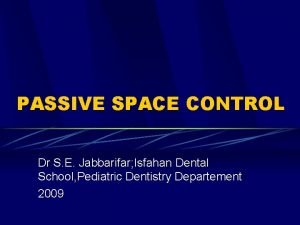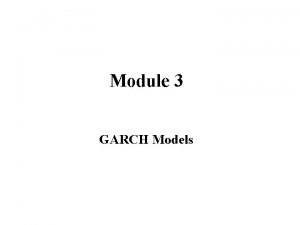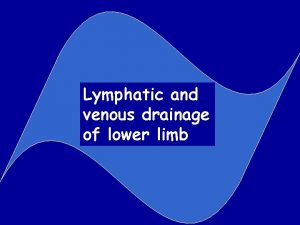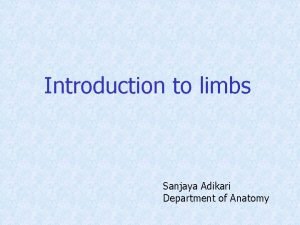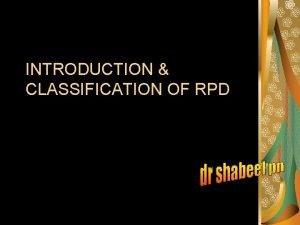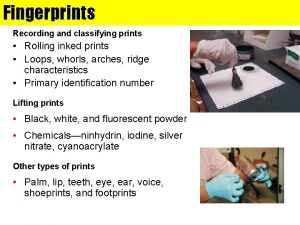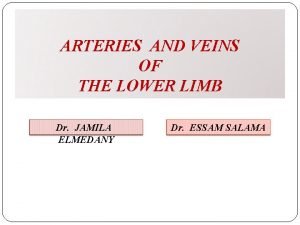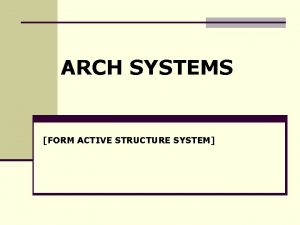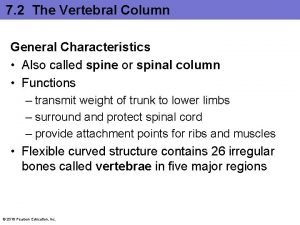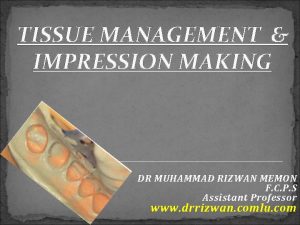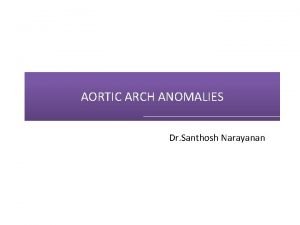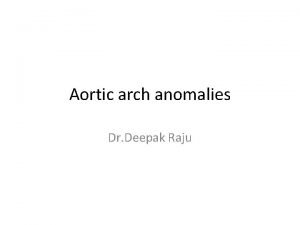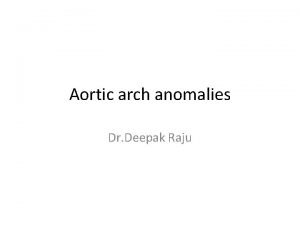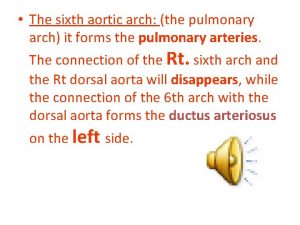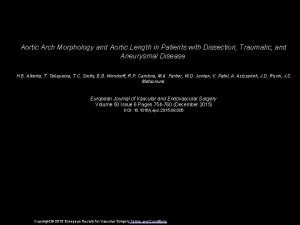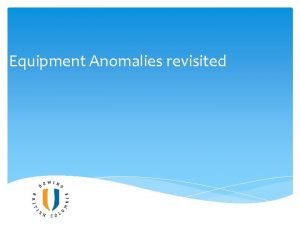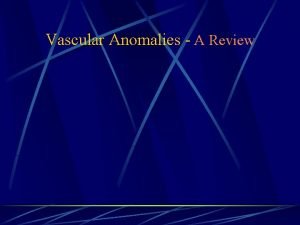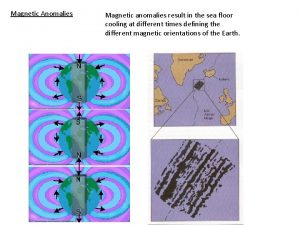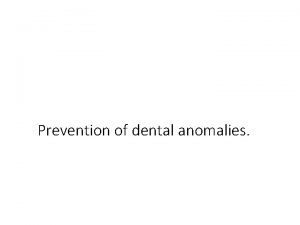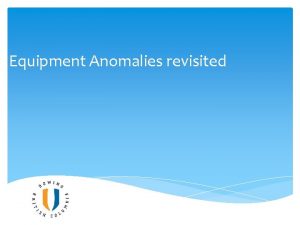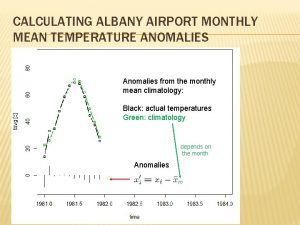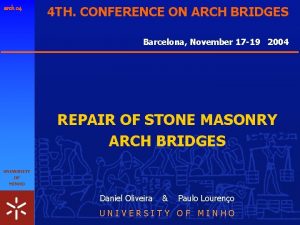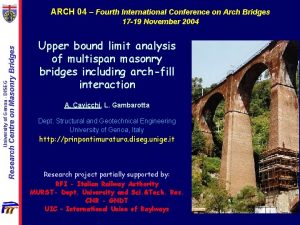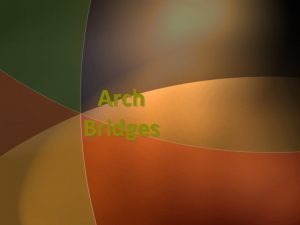Aortic Arch Anomalies 1 Development of Aortic Arch







































































































- Slides: 103

Aortic Arch Anomalies 1

Development of Aortic Arch and great vessels 2

3

4

5

6

7

8

9

10

11

12

13

14

15

16

17

18

19

20

21

22

23

Anatomical Categories • • Abnormalities of branching 1. Normal L Aortic Arch & Variants 2. Abnormal L Aortic Arch Abnormalities of arch position 3. R Aortic Arch 4. Cervical Aortic Arch • Superpneumarary arches 5. Double Aortic Arch 6. Persistent Fifth AA 7. Interrupted Aortic Arch 8. Anomalous origin of PA branches and other AA anomalies 24

Clinical Classification • Vascular rings • Non ring vascular compression of trachea, bronchi, oesophagus • Non compressive arch malformation • Duct dependent arch anomalies 25

Clinical features of vascular rings • • • Stridor – increase with RTI Recurrent pneumonia/ bronchitis Hyperextension of neck (esp. in infants) Reflex apnoea associated with eating Swallowing difficulty Chocking of food 26

Sidedness of Aortic arch • L & R aortic arch definitions – Refers to which bronchus is crossed by the arch • Normal – – Cross the L main bronchus at T 5 – Branching…. general rule – 1 st arch vessel contain a carotid a. contralateral to Ao A • Importance of sidedness of Ao arch • BT shunt – on side of In A • Repair of oesophageal atresia – side opp arch 27

Anatomical Categories • Abnormalities of branching 1. Normal L Aortic Arch & Variants 2. • Abnormal L Aortic Arch Abnormalities of arch position 3. R Aortic Arch 4. Cervical Aortic Arch • Superpneumarary arches 5. Double Aortic Arch 6. Persistent Fifth AA 7. Interrupted Aortic Arch 8. Anomalous origin of PA branches and other AA anomalies 28

1. Normal L Aortic Arch & Variants 1. Common brachiocephalic trunk • • Present in 10% of L arches No consequences 29

1. Normal L Aortic Arch & Variants 2. Separate origin of L vertebral a. from aortic arch (normal – from L subclavian) • • Size 1>2, 3<4 DD – anomalous R SCA 30

Anatomical Categories • Abnormalities of branching 1. Normal L Aortic Arch & Variants 2. Abnormal L Aortic Arch • Abnormalities of arch position 3. R Aortic Arch 4. Cervical Aortic Arch • Superpneumarary arches 5. Double Aortic Arch 6. Persistent Fifth AA 7. Interrupted Aortic Arch 8. Anomalous origin of PA branches and other AA anomalies 31

2. Abnormal L Aortic Arch 1. L AA with retroesophageal R SCA 2. L AA with R Desc Ao & R ductus 32

2. 1 L AA with retroesophageal R SCA • Most common arch anomaly – 0. 5% of general population • Higher incidence in Downs with CHD – 38% • Mostly asymptomatic 33

2. 1 L AA with retroesophageal R SCA • Diagnosis – Echo/angio • • Branch sizes of 1=2, 3=4 1 st – no bifurcation, goes to R 2 nd, 3 rd – to L, non bifurcating 4 th – towards R, disappear behind trachea 34

2. 1 L AA with retroesophageal R SCA – Ba oesophagography • Small filling defect slanting up and R – MRI 35

2. 2 L AA with R Desc Ao & R ductus • Branching pattern similar to previous • Rare • Arch – retro-oesophageal • Desc Ao connected to PA by R ductus ring 36

2. 2 L AA with R Desc Ao & R ductus • Diagnosis • Suspect when symps of vascular ring + L aortic arch present – Cx. R • L Ao A + R upper desc. Ao (adults) 37

2. 2 L AA with R Desc Ao & R ductus • Diagnosis – Ba oesophagography • Large indentation directed up and L • DD – R Ao A with retro-oesophageal diverticulum – Angiography, MRI 38

2. 2 L AA with R Desc Ao & R ductus • Rx – R thoracotomy & division of ring 39

Anatomical Categories • • Abnormalities of branching 1. Normal L Aortic Arch & Variants 2. Abnormal L Aortic Arch Abnormalities of arch position 3. R Aortic Arch 4. Cervical Aortic Arch • Superpneumarary arches 5. Double Aortic Arch 6. Persistent Fifth AA 7. Interrupted Aortic Arch 8. Anomalous origin of PA branches and other AA anomalies 40

3. R Aortic Arch • Definition – Single aortic arch that crosses over the R main bronchus passing to the R of the trachea 41

3. R Aortic Arch Major types 1. R AA with mirror image branching 2. R AA with retro-oesophageal L SCA 3. R AA with retro-oesophageal diverticulum 4. R AA with L descending aorta 42

3. R Aortic Arch • 13 - 34% of TOF have RAA • Incidence in Truncus Arteriosus > that of TOF • 8% of DTGA, 16% of TGA+VSD+PS have RAA 43

3. 1 RAA with Mirror Image Branching • Almost always ass. with congenital intracardiac disease – Conotruncal anomalies – TOF, TA, TGA, DORV, LTGA, PA with RV aorta – Other lesions – VSD, PA with IVS • Ductus is commonly L sided - attached to L innom. A. – no vascular ring 44

3. 1 RAA with Mirror Image Branching • Diagnosis • Usually no retro-oesophageal compression/ vascular ring • Echo/Angio • Distinctive branching pattern • Cx. R/ Ba oesophagography • R indentation of trachea/oesophagus • Treatment • RAA only - No Rx needed 45

3. 1 RAA with Mirror Image Branching • Variant – – L ductus to RE diverticulum from R Desc Ao Vascular ring No arch vv from diverticulum (Rarely true mirror image of normal – L ductus disappear and R 6 th arch continue as ductus) 46

3. 2 RAA with Retro-oesophageal diverticulum (Of Kommerell) • vascular ring+ • Many asymptomatic, in most no other heart defect 47

3. 2 RAA with Retro-oesophageal diverticulum (Of Kommerell) • Diagnosis – – – Presentation – vascular ring +Cx. R – R AA ? RE Div of Com Ba Oesophagogram Echo Angio – charact branching pattern, abrupt change in caliber from diverticulum to SCA – MRI 48

3. 2 RAA with Retro-oesophageal diverticulum (Of Kommerell) • Rx – Symptomatic – Sx division of ligamentum (L thoracotomy/ Median sternotomy) – If resp symps/ dysphagia – resection of entire diverticulum (R thoracotomy) 49

3. 3 R AA with Retro-oesophageal L SCA • • Loss of L 6 th ductal arch and persistence of R 6 th No vascular ring Smaller posterior indentation of Oesophagus Rx not needed (no ring) except for ass anomalies 50

3. 4 R AA with L Desc Ao & L ductus • Diagnosis – Cx. R, Ba Study – Echo – branching pattern + L desc Ao – Angio – difficult to DD from Normal L AA – go by branching pattern – MRI • Rx – when symptomatic need division 51

3. 5 R AA with Retro-oesophageal Innom A. • Vascular ring+ • Very rare • Site of arch dissolution – L branch of aortic sac (Exception to the general rule – 1 st arch vessel contain a carotid a. contralateral to Ao A. ) 52

3. 5 R AA with Retro-oesophageal Innom A. • Diagnosis – Single carotid A. arising from prox. Aorta • DD – interrupted AA, isolated L carotid/Innominate A. • Differentiating feature – normal size AA • Rx – Division of the ring if symptomatic if still symptomatic detachment of Inn a and reimplantation in to AA 53

3. 6 RAA with isolation of contralateral arch vessels • Uncommon • Vessel arises exclusively from PA via ductus arteriosus without connection to aorta • 3 different forms • CHD + in > 50% of cases • > 2/3 have TOF • Most common isolation – isolated SCA 54

3. 6 RAA with isolation of contralateral arch vessels 1. Isolation of L SCA • Dissolution – L 4 th arch & L distal dorsal Ao 55

3. 6 RAA with isolation of contralateral arch vessels 2. Isolation of L CCA • Dissolution – L 4 th arch & L horn of aortic sac with 6 th arch connecting to 3 rd arch 56

3. 6 RAA with isolation of contralateral arch vessels 3. Isolation of L Innom. A • Dissolution – L horn of aortic sac and distal L dorsal aorta 57

3. 6 RAA with isolation of contralateral arch vessels • Clinical F. – Low pulse volume/ BP in affected artery – When subclavian and vertebral A are involved – subclavian steal syndrome – Cerebral insufficiency, L arm ischaemia – If ductus remain patent – PA steal (flow down vertebral a. in to low res. PA) – Suspect – RAA+ low pulse in L UL 58

3. 6 RAA with isolation of contralateral arch vessels • Diagnosis – Angio – delayed filling of SCA – BA oesophagography – not helpful – Doppler echo – reversal of flow in vertebral artery • Rx – Repair of CHD + ligation of ductus if patent to prevent steal – CNS syms/ claudication of arm – surgical reimplantation of SCA to aorta 59

Anatomical Categories • • Abnormalities of branching 1. Normal L Aortic Arch & Variants 2. Abnormal L Aortic Arch Abnormalities of arch position 3. R Aortic Arch 4. • Cervical Aortic Arch Superpneumarary arches 5. Double Aortic Arch 6. Persistent Fifth AA 7. Interrupted Aortic Arch 8. Anomalous origin of PA branches and other AA anomalies 60

4. Cervical Aortic Arch • Rare anomaly • AA above the level of clavicle • Two main subcategories 61

4. Cervical Aortic Arch • Embryological explanation 1. Persistence of ductus caroticus + involution of 4 th arch 3 rd arch becomes AA (int & ext carotid arising separately) 2. Failure of the normal descent of AA • At 3/52 of POA – cephalic location at 7/52 POA intrathoracic location 62

4. Cervical Aortic Arch 1. Contralateral descending Ao. and Anomalous SCA – Usually RAA – Descend to T 4 level – cross behind Oeso. to L – gives off L SCA & Ductus – vascular ring 2. Ipsilateral descending aorta and normal branch pattern – Typically LAA – non ring – AA obstruction due to long, tortuous, hypoplastic, retroesophageal segment 63

4. Cervical Aortic Arch Presentations: – Pulsatile masses in supraclavicualar fossa in neck • DD – aneurysm of carotid/ SCA • Differentiation – compression of pulsatile mass loss of femoral pulse • – Vascular ring – Subclavian steal syndrome Cx. R – Wide upper mediastinum + absent aortic knob – Anterior deviation of trachea 64

4. Cervical Aortic Arch – Rx necessary – If hypoplasia of cervical arch+ – Symptomatic vascular ring – Aneurysm of cervical arch itself 65

Anatomical Categories • • Abnormalities of branching 1. Normal L Aortic Arch & Variants 2. Abnormal L Aortic Arch Abnormalities of arch position 3. R Aortic Arch 4. Cervical Aortic Arch • Superpneumarary arches 5. Double Aortic Arch 6. Persistent Fifth AA 7. Interrupted Aortic Arch 8. Anomalous origin of PA branches and other AA anomalies 66

5. Double Aortic Arch • Both R & L arches persist • Vascular ring + • Variations + – Hypoplasia of one arch (usually L) – Atresia of one arch (usually L) – Both arches widely patent • R arch is more superiorly located 67

5. Double Aortic Arch 1. Double AA with both arches patent • Symmetrical origin of 4 brachiocephalic Aa 68

5. Double Aortic Arch 2. Double AA with atretic L arch distal to the origin of L SCA • • Similar to mirror image RAA (but with L Desc Ao) Indistinguishable (except at Sx) from RAA with L DA 69

5. Double Aortic Arch 3. Double AA with atretic segment between L CCA and L SCA • Similar to RAA with diverticulum of Kommerell 70

5. Double Aortic Arch 4. Atretic R arch • • Rare Can simulate L atresia patterns 71

5. Double Aortic Arch • Descending aorta could be L or R • Rarely ass. with CHD • TOF is most common • TGA • Embryological explanation • Both 4 th arches and dorsal aortae persist • But usually one 6 th arch (ductus) 72

5. Double Aortic Arch Clinical features – vascular ring – syms depend on tightness of ring • When both arches widely patent tight ring stridor in 1 st wk • Atretic L arch loose ring present at 3 -6/12 or later • Rarely double AA present in adulthood with swallowing/resp. syms Diagnosis – Cx. R – RAA indent trachea superiorly and LAA inferiorly – Ba oeso, Echo, Angio, MRI confirm diagnosis 73

5. Double Aortic Arch • Mx – If symps + due to vascular ring Sx division – If undergoing Sx for other CHD division – Ring should be divided in the smaller limb – Ligamentum also should be divided 74

Anatomical Categories • • Abnormalities of branching 1. Normal L Aortic Arch & Variants 2. Abnormal L Aortic Arch Abnormalities of arch position 3. R Aortic Arch 4. Cervical Aortic Arch • Superpneumarary arches 5. Double Aortic Arch 6. Persistent Fifth AA 7. Interrupted Aortic Arch 8. Anomalous origin of PA branches and other AA anomalies 75

6. Persistent Fifth AA • Rare • Both arches appear on the same side of trachea • Can be ass with COA • 3 Subtypes • Except for COA 1 st & 2 nd subtypes – no physiological significance 76

6. Persistent Fifth AA 1. Double lumen AA with both lumina patent • Frequently ass with major cardiac anomaly 77

6. Persistent Fifth AA 2. Atresia/interruption of the superior arch (4 th) with patent inferior (5 th) arch • • Common origin of all brachiocephalic vessels from the ascending aorta Can be ass with COA 78

6. Persistent Fifth AA 3. Systemic to pulmonary artery connection arising proximal to 1 st brachiocephalic Vv – – – Only in pulmonary atresia 5 th arch remnant arises as the 1 st branch of the Asc Ao – connects to the junction of MPA and one branch PA Ipsilateral/contralateral to definitive AA (4 th) 79

6. Persistent Fifth AA Diagnosis • “Subway” vessel beneath the normal arch • In atresia of superior arch common brachiocephalic trunk with all 4 vv arising from single v • Branching pattern persistent 5 th arch – Atretic segment not visualized in Ixs – At Sx – fibrous band + between L SCA and Desc Ao 80

Anatomical Categories • • Abnormalities of branching 1. Normal L Aortic Arch & Variants 2. Abnormal L Aortic Arch Abnormalities of arch position 3. R Aortic Arch 4. Cervical Aortic Arch • Superpneumarary arches 5. Double Aortic Arch 6. Persistent Fifth AA 7. Interrupted Aortic Arch 8. Anomalous origin of PA branches and other AA anomalies 81

7. Interrupted Aortic Arch • Complete separation of ascending and descending aorta Determination of sidedness of AA – Branching pattern- 1 st Br. Prox to Int. contains a Carotid a. opposite the side of the AA – Retroesophageal/ isolated subclavian a is always opposite the side of the arch – Importance of sidedness • Interrupted R AA – only seen in ass with Digeorge syndrome 82

7. Interrupted Aortic Arch 3 main categories 9 sub categories Main categories A. Interruption distal to SCA that is ipsilateral to 2 nd Carotid A B. Interruption between 2 nd carotid and ipsilateral SCA C. Interruption between carotid arteries Subcategories 1. Without retro-esophageal or isolated SCA 2. With retro-esophageal SCA 3. With isolated SCA 83

7. Interrupted Aortic Arch A. Interruption distal to SCA that is ipsilateral to 2 nd Carotid A – associations – Aortico-pulmonary septal defects + Intact IVS – TGA + Interrupted AA 84

7. Interrupted Aortic Arch B. Interruption between 2 nd carotid and ipsilateral SCA – – Without retro-esophageal or isolated SCA More common than type A 85

7. Interrupted Aortic Arch B. Interruption between 2 nd carotid and ipsilateral SCA – With retro-esophageal SCA – Digeorge syndrome + interruption have type B 86

7. Interrupted Aortic Arch A. Interruption between carotid arteries – Rare 87

7. Interrupted Aortic Arch Associations Digeorge syndrome Vs IAA / Truncus – 43% of Digeorges had type B interruption – 68% of IAA had Digeorge – 34% of Digeorges had TA – 33% of TA had Digeorge 88

7. Interrupted Aortic Arch Presentation – – Duct dependant L heart obstructive lesions Acute cardiovascular collapse / heat failure after spont closure of PDA after 1 st few days of life • Initial Mx – Fluid resuscitation – Induction and maintenance of ductal patency with PGE 1 – Inotropic support SOS Clinical features – pulse discrepancy – depends on branching pattern • Absence of all limb pulses type B interruption with anomalous SCA – DD - critical AS (carotid pulse is also week) 89

7. Interrupted Aortic Arch Differential cyanosis – pink upper body + blue lower body – Uncommonly seen b’se pulm blood is also highly saturated due to large L R shunt through VSD 90

7. Interrupted Aortic Arch • Diagnosis – Echocardiogram • • Most important tool for diagnosis of IAA Suspect when – Marked discrepancy between Asc Ao and MPA + malalignment VSD + posterior deviation of infundibular septum (PS LAX) – Angiography • • • Difficult b’se high flow through VSD poor image quality of Asc Ao Can diagnose when both carotids prox and both SCA distal to interruption Wide separation of carotids from Desc Ao IAA 91

7. Interrupted Aortic Arch Management – Sx approach depend on degree of subaortic obstruction • Subaortic diameter > 5 -6 mm 1 ry repair – (patch closure of VSD + Ao Arch reconstruction) • Subaortic diameter < 3 mm – inadequate to support normal COP 92

7. Interrupted Aortic Arch • PA banding – is not a satisfactory palliation for VSD with interrupted Ao A – Will lead to BVH with progressive subaortic stenosis complicate definitive repair • Repair of Ao Arch – direct anastomosis + homograft augmentation – In infancy avoid artificial tube grafts • Rapidly overgrown • Fibrous encasement – complicate later repair 93

Anatomical Categories • • Abnormalities of branching 1. Normal L Aortic Arch & Variants 2. Abnormal L Aortic Arch Abnormalities of arch position 3. R Aortic Arch 4. Cervical Aortic Arch • Superpneumarary arches 5. Double Aortic Arch 6. Persistent Fifth AA 7. Interrupted Aortic Arch 8. Anomalous origin of PA branches and other AA anomalies 94

8. Other Anomalies of the Aortic Arch System 1. Anomalous origin of the pulmonary artery from the ascending aorta 2. Anomalous origin of the LPA from the RPA 3. Innominate artery compression of the trachea 95

8. 1 Anomalous origin of the pulmonary artery from the ascending aorta • One branch PA arising from Asc Ao + MPA arising separately from the heart • RPA more commonly arise from Ao (82%) 96

8. 1 Anomalous origin of the pulmonary artery from the ascending aorta Investigations – Cx. R – differential PBF (esp in TOF with oligemia) – Echo – diagnostic • Carefully search for origins of both PAs in TOF – Cardiac catheterization • Only one branch PA can be reached through RV – MRI - diagnostic 97

8. 2 Anomalous origin of LPA from RPA • Pulm artery sling + partially surround lower trachea • only situation with major vascular structure passing between trachea and oesophagus • ass with complete cartilaginous rings in distal trachea Tracheal stenosis (need direct surgical treatment in addition to relief from vascular compression) 98

8. 2 Anomalous origin of LPA from RPA • Sx – division of LPA from RPA and reanastomosis in front of the trachea – Transect the trachea and reanastomose behind the PA bifurcation – If complete cartilaginous tracheal rings + tracheal reconstruction 99

8. 3 Innominate Artery Compression of Trachea • Poorly understood condition • Anterior compression of the trachea at the point where it is crossed by the innominate artery • Suspect – When signs of severe insp and exp stridor in a 2 -6 mo old + anterior indentation of the tracheal air column in lateral Cx. R 100

8. 3 Innominate Artery Compression of Trachea Rx – Wait for tracheomalacia to resolve typically by age 2 yrs – In patients with apnea/ repeated LRTI – surgical suspension of the innominate artery from the sternum 101

Summary • Aortic arch anomalies and ring malformations can be worked out from the basic embryologic structure • So try to remember the embryology rather than anomalies itself • Can argue against certain lesions eg RAA with R innominate • Diagnosis has become easier with 3 D reconstruction • Treatment needed only when symptomatic or associated with other cardiac problems 102

Thank You 103
 Major arteries of the systemic circulation
Major arteries of the systemic circulation Major arteries of the body
Major arteries of the body Branches off aortic arch
Branches off aortic arch Truncus arterioso
Truncus arterioso Coarcitation of aorta
Coarcitation of aorta Art labeling activity figure 19.26b
Art labeling activity figure 19.26b Database anomalies
Database anomalies Vitelline fistula
Vitelline fistula Pyriform aperture stenosis
Pyriform aperture stenosis Hypobranchial eminence
Hypobranchial eminence Modification anomalies
Modification anomalies Attention anomalies
Attention anomalies Anomalie rcf
Anomalie rcf Accommodation anomalies
Accommodation anomalies Convex population pyramid
Convex population pyramid Anomalies du rcf pendant le travail
Anomalies du rcf pendant le travail Kode icd 10 palatoschisis
Kode icd 10 palatoschisis Oddball: spotting anomalies in weighted graphs
Oddball: spotting anomalies in weighted graphs The criminal man
The criminal man Roulure bois
Roulure bois Andrea frazzini aqr
Andrea frazzini aqr Causes of congenital anomalies
Causes of congenital anomalies Causes of congenital anomalies
Causes of congenital anomalies Data redundancy and update anomalies
Data redundancy and update anomalies Cfsv2 monthly prec anomalies
Cfsv2 monthly prec anomalies Erythroplasia of queyrat
Erythroplasia of queyrat Elliptocytosis
Elliptocytosis Blood pressure measurement methods
Blood pressure measurement methods Aortic area 1 and 2
Aortic area 1 and 2 Aortic valve anatomy
Aortic valve anatomy Lumbocostal triangle
Lumbocostal triangle Aortic impression lung
Aortic impression lung Dvi aortic valve
Dvi aortic valve Pulmonary ligament
Pulmonary ligament Dvi aortic valve
Dvi aortic valve Features of aortic stenosis
Features of aortic stenosis Rete testis
Rete testis Dvi aortic valve
Dvi aortic valve Continuity equation echo
Continuity equation echo Mitral regurgitation murmur
Mitral regurgitation murmur Aortic valve dimensionless index
Aortic valve dimensionless index Aortic body
Aortic body Cardio thoracic ratio
Cardio thoracic ratio Aortic knob
Aortic knob Thoracic aortic aneurysm
Thoracic aortic aneurysm Aortic pressure curve
Aortic pressure curve Aortic valve leaflets
Aortic valve leaflets Dobutamine dose
Dobutamine dose Right marginal artery
Right marginal artery Peripheral signs of aortic regurgitation
Peripheral signs of aortic regurgitation Good morning blood
Good morning blood Anterior aortic sinus
Anterior aortic sinus Aortic disection
Aortic disection Aortic stanosis
Aortic stanosis 120 mm/hg
120 mm/hg Aortic bifurcation surface anatomy
Aortic bifurcation surface anatomy Type b aortic dissection
Type b aortic dissection Aortic semilunar valve sheep heart
Aortic semilunar valve sheep heart Oblique sinus
Oblique sinus Left lymphatic duct
Left lymphatic duct Pathophysiology of aortic aneurysm ppt
Pathophysiology of aortic aneurysm ppt /watch?v=zpqlqsmpqt0
/watch?v=zpqlqsmpqt0 Structure of the heart
Structure of the heart Sinus of valsalva
Sinus of valsalva Thorasic aortic aneurysm
Thorasic aortic aneurysm Facs
Facs Historical development of community
Historical development of community Development that ended much development crossword
Development that ended much development crossword What is the purpose of the
What is the purpose of the Arch alcohol
Arch alcohol Brachial vein
Brachial vein Scapula lymph nodes
Scapula lymph nodes Recurrent ulnar artery
Recurrent ulnar artery Passive space maintainer
Passive space maintainer Proscenium stage model
Proscenium stage model Island ridge minutiae
Island ridge minutiae Arch feedback model
Arch feedback model Band and loop cementation
Band and loop cementation Roof of nasal cavity
Roof of nasal cavity Arch model
Arch model Arch pg
Arch pg Arch model
Arch model Metody pedagogické diagnostiky
Metody pedagogické diagnostiky Posterior arch vein
Posterior arch vein Posterior arch vein
Posterior arch vein Applegate rule
Applegate rule Cross arch stabilization
Cross arch stabilization Doryphoros
Doryphoros Gothic arch greenhouse advantages
Gothic arch greenhouse advantages Keystone of lateral longitudinal arch
Keystone of lateral longitudinal arch Arch fingerprint percentage
Arch fingerprint percentage Afis fingerprint
Afis fingerprint The first principle of fingerprinting states:
The first principle of fingerprinting states: Fingerprint basics
Fingerprint basics Arch deluxe
Arch deluxe Left slant loop
Left slant loop Skewback in arch
Skewback in arch Femoral pulse location
Femoral pulse location Active structure
Active structure Monor arc
Monor arc Vertbral arch
Vertbral arch Lymphatic drainage
Lymphatic drainage Define thrust stage
Define thrust stage Dual arch impression technique
Dual arch impression technique
